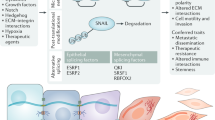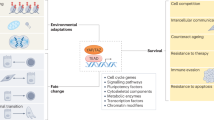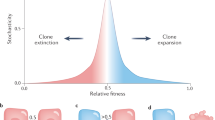Abstract
Stem cell biology has come of age. Unequivocal proof that stem cells exist in the haematopoietic system has given way to the prospective isolation of several tissue-specific stem and progenitor cells, the initial delineation of their properties and expressed genetic programmes, and the beginnings of their utility in regenerative medicine. Perhaps the most important and useful property of stem cells is that of self-renewal. Through this property, striking parallels can be found between stem cells and cancer cells: tumours may often originate from the transformation of normal stem cells, similar signalling pathways may regulate self-renewal in stem cells and cancer cells, and cancer cells may include 'cancer stem cells' — rare cells with indefinite potential for self-renewal that drive tumorigenesis.
This is a preview of subscription content, access via your institution
Access options
Subscribe to this journal
Receive 51 print issues and online access
$199.00 per year
only $3.90 per issue
Buy this article
- Purchase on Springer Link
- Instant access to full article PDF
Prices may be subject to local taxes which are calculated during checkout





Similar content being viewed by others
References
Spangrude, G. J., Heimfeld, S. & Weissman, I. L. Purification and characterization of mouse hematopoietic stem cells. Science 241, 58–62 (1988).
Morrison, S. J. & Weissman, I. L. The long-term repopulating subset of hematopoietic stem cells is deterministic and isolatable by phenotype. Immunity 1, 661–673 (1994).
Baum, C. M., Weissman, I. L., Tsukamoto, A. S., Buckle, A. M. & Peault, B. Isolation of a candidate human hematopoietic stem-cell population. Proc. Natl Acad. Sci. USA 89, 2804–2808 (1992).
Osawa, M., Hanada, K., Hamada, H. & Nakauchi, H. Long-term lymphohematopoietic reconstitution by a single CD34-low/negative hematopoietic stem cell. Science 273, 242–245 (1996).
Akashi, K. & Weissman, I. L. in Developmental Biology of Hematopoiesis (ed. Zon, L. I.) 15–34 (Oxford Univ. Press, New York, 2001).
Petersen, B. E. et al. Bone marrow as a potential source of hepatic oval cells. Science 284, 1168–1170 (1999).
Brazelton, T. R., Rossi, F. M. V., Keshet, G. I. & Blau, H. M. From marrow to brain: expression of neuronal phenotypes in adult mice. Science 290, 1775–1779 (2000).
Mezey, E., Chandross, K. J., Harta, G., Maki, R. A. & McKercher, S. R. Turning blood into brain: cells bearing neuronal antigens generated in vivo from bone marrow. Science 290, 1779–1782 (2000).
Lagasse, E. et al. Purified hematopoietic stem cells can differentiate to hepatocytes in vivo. Nature Med. 6, 1229–1234 (2000).
Krause, D. S. et al. Multi-organ, multi-lineage engraftment by a single bone marrow derived stem cell. Cell 105, 369–377 (2001).
Morrison, S. J., Wandycz, A. M., Hemmati, H. D., Wright, D. E. & Weissman, I. L. Identification of a lineage of multipotent hematopoietic progenitors. Development 124, 1929–1939 (1997).
Weissman, I. L. Translating stem and progenitor cell biology to the clinic: barriers and opportunities. Science 287, 1442–1446 (2000).
Miller, C. L. & Eaves, C. J. Expansion in vitro of adult murine hematopoietic stem cells with transplantable lympho-myeloid reconstituting ability. Proc. Natl Acad. Sci. USA 94, 13648–13653 (1997).
Domen, J., Gandy, K. L. & Weissman, I. L. Systemic overexpression of BCL-2 in the hematopoietic system protects transgenic mice from the consequences of lethal irradiation. Blood 91, 2272–2282 (1998).
Domen, J. & Weissman, I. L. Hematopoietic stem cells need two signals to prevent apoptosis; BCL-2 can provide one of these, Kitl/c-Kit signaling the other. J. Exp. Med. 192, 1707–1718 (2000).
Taipale, J. & Beachy, P. A. The Hedgehog and Wnt signaling pathways in cancer. Nature 411, 349–354 (2001).
Varnum-Finney, B. et al. Pluripotent, cytokine-dependent, hematopoietic stem cells are immortalized by constitutive Notch1 signaling. Nature Med. 6, 1278–1281 (2000).
Karanu, F. N. et al. The Notch ligand Jagged-1 represents a novel growth factor of human hematopoietic stem cells. J. Exp. Med. 192, 1365–1372 (2000).
Bhardwaj, G. et al. Sonic hedgehog induces the proliferation of primitive human hematopoietic cells via BMP regulation. Nature Immunol. 2, 172–180 (2001).
Nusse, R. & Varmus, H. E. Many tumors induced by the mouse mammary tumor virus contain a provirus integrated in the same region of the host genome. Cell 31, 99–109 (1982).
Cadigan, K. M. & Nusse, R. Wnt signaling: a common theme in animal development. Genes Dev. 11, 3286–3305 (1997).
Reya, T. et al. Wnt signaling regulates B lymphocyte proliferation through a LEF-1 dependent mechanism. Immunity 13, 15–24 (2000).
Austin, T. W., Solar, G. P., Ziegler, F. C., Liem, L. & Matthews, W. A role for the Wnt gene family in hematopoiesis: expansion of multilineage progenitor cells. Blood 89, 3624–3635 (1997).
Van Den Berg, D. J., Sharma, A. K., Bruno, E. & Hoffman, R. Role of members of the Wnt gene family in human hematopoiesis. Blood 92, 3189–3202 (1998).
Zhu, A. J. & Watt, F. M. β-catenin signalling modulates proliferative potential of human epidermal keratinocytes independently of intercellular adhesion. Development 126, 2285–2298 (1999).
Gat, U., DasGupta, R., Degenstein, L. & Fuchs, E. De novo hair follicle morphogenesis and hair tumors in mice expressing a truncated β-catenin in skin. Cell 95, 605–614 (1998).
Korinek, V. et al. Depletion of epithelia stem-cell compartments in the small intestine of mice lacking Tcf-4. Nature Genet. 19, 1–5 (1998).
Sell, S. & Pierce, G. B. Maturation arrest of stem cell differentiation is a common pathway for the cellular origin of teratocarcinomas and epithelial cancers. Lab. Invest. 70, 6–22 (1994).
Sawyers, C., Denny, C. & Witte, O. Leukemia and the disruption of normal hematopoiesis. Cell 64, 337–350 (1991).
Kondo, M., Weissman, I. L. & Akashi, K. Identification of clonogenic common lymphoid progenitors in mouse bone marrow. Cell 91, 661–672 (1997).
Bonnet, D. & Dick, J. E. Human acute myeloid leukemia is organized as a hierarchy that originates from a primitive hematopoietic cell. Nature Med. 3, 730–737 (1997).
Miyamoto, T., Weissman, I. L. & Akashi, K. AML1/ETO-expressing nonleukemic stem cells in acute myelogenous leukemia with 8;21 chromosomal translocation. Proc. Natl Acad. Sci. USA 97, 7521–7526 (2000).
George, A. A. et al. Detection of leukemic cells in the CD34+CD38− bone marrow progenitor population in children with acute lymphoblastic leukemia. Blood 97, 3925–3930 (2001).
Mauro, M. J. & Druker, B. J. Chronic myelogenous leukemia. Curr. Opin. Oncol. 13, 3–7 (2001).
Lagasse, E. & Weissman, I. L. bcl-2 inhibits apoptosis of neutrophils but not their engulfment by macrophages. J. Exp. Med. 179, 1047–1052 (1994).
Traver, D., Akashi, K., Weissman, I. L. & Lagasse, E. Mice defective in two apoptosis pathways in the myeloid lineage develop acute myeloblastic leukemia. Immunity 9, 47–57 (1998).
Polakis, P. Wnt signaling and cancer. Genes Dev. 14, 1837–1851 (2000).
Tsukamoto, A., Grosschedl, R., Guzman, R., Parslow, T. & Varmus, H. E. Expression of the int-1 gene in transgenic mice is associated with mammary gland hyperplasia and adenocarcinomas in male and female mice. Cell 55, 619–625 (1988).
Weissman, I. L. & Baird, S. in Neoplastic Transformation: Mechanisms and Consequences (ed. Korprowski, H.) 135–152 (Dahlem Conferenzen, Berlin, 1977).
McGrath, M. S. & Weissman, I. L. AKR leukemogenesis: identification and biological significance of thymic lymphoma receptors for AKR retroviruses. Cell 17, 65–75 (1979).
McGrath, M. S., Pillemer, E. & Weissman, I. L. Murine leukaemogenesis: monoclonal antibodies to T-cell determinants arrest T-lymphoma cell proliferation. Nature 285, 259–261 (1980).
Quinn, E. R. et al. The B cell receptor of a hepatitis C virus associated non-Hodgkin's lymphoma binds the viral E-2 envelope protein, implicating immunoglobulin activation in lymphomagenesis. Blood (in the press).
O'Neill, H. C., McGrath, M. S., Allison, J. P. & Weissman, I. L. A subset of T cell receptors associated with L3T4 molecules mediates C6VL leukemia cell binding of its cognate retrovirus. Cell 49, 143–151 (1987).
Morrison, S. J., Shah, N. M. & Anderson, D. J. Regulatory mechanisms in stem cell biology. Cell 88, 287–298 (1997).
Kummermehr, J. & Trott, K.-R. in Stem Cells (ed. Potten, C. S.) 363–399 (Academic, New York, 1997).
Fidler, I. J. & Kripke, M. L. Metastasis results from preexisting variant cells within a malignant tumor. Science 197, 893–895 (1977).
Fidler, I. J. & Hart, I. R. Biological diversity in metastatic neoplasms: origins and implications. Science 217, 998–1003 (1982).
Heppner, G. H. Tumor heterogeneity. Cancer Res. 44, 2259–2265 (1984).
Nowell, P. C. Mechanisms of tumor progression. Cancer Res. 46, 2203–2207 (1986).
Nowell, P. C. A minute chromosome in human granulocytic leukemia. Science 132, 1497 (1960).
Fialkow, P. J. Clonal origin of human tumors. Biochim. Biophys. Acta 458, 283–321 (1976).
Fearon, E. R., Hamilton, S. R. & Vogelstein, B. Clonal analysis of human colorectal tumors. Science 238, 193–197 (1987).
Park, C. H., Bergsagel, D. E. & McCulloch, E. A. Mouse myeloma tumor stem cells: a primary cell culture assay. J. Natl Cancer Inst. 46, 411–422 (1971).
Bruce, W. R. & Gaag, H. v. d. A quantitative assay for the number of murine lymphoma cells capable of proliferation in vivo. Nature 199, 79–80 (1963).
Wodinsky, I., Swiniarski, J. & Kensler, C. J. Spleen colony studies of leukemia L1210. I. Growth kinetics of lymphocytic L1210 cells in vivo as determined by spleen colony assay. Cancer Chemother. Rep. 51, 415–421 (1967).
Bergsagel, D. E. & Valeriote, F. A. Growth characteristics of a mouse plasma cell tumor. Cancer Res. 28, 2187–2196 (1968).
Bonnet, D. & Dick, J. E. Human acute myeloid leukemia is organized as a hierarchy that originates from a primitive hematopoietic cell. Nature Med. 3, 730–737 (1997).
Southam, C. M. & Brunschwig, A. Quantitative studies of autotransplantation of human cancer. Cancer 14, 971–978 (1961).
Hamburger, A. W. & Salmon, S. E. Primary bioassay of human tumor stem cells. Science 197, 461–463 (1977).
Salsbury, A. J. The significance of the circulating cancer cell. Cancer Treatment Rev. 2, 55–72 (1975).
Williams, S. D. Treatment of disseminated germ cell tumors with cisplatin, bleomycin, and either vinblastine or etoposide. N. Engl. J. Med. 316, 1435–1439 (1987).
Stockler, M., Wilcken, N. R. C., Ghersi, D. & Simes, R. J. Systematic reviews of chemotherapy and endocrine therapy in metastatic breast cancer. Cancer Treatment Rev. 26, 151–168 (2000).
Lippman, M. E. High-dose chemotherapy plus autologous bone marrow transplantation for metastatic breast cancer. N. Engl. J. Med. 342, 1119–1120 (2000).
Harrison, D. E. & Lerner, C. P. Most primitive hematopoietic stem cells are stimulated to cycle rapidly after treatment with 5-fluorouracil. Blood 78, 1237–1240 (1991).
Bouwens, L. & DeBlay, E. Islet morphogenesis and stem cell markers in rat pancreas. J. Histochem. Cytochem. 44, 947–951 (1996).
Peters, R., Leyvraz, S. & Perey, L. Apoptotic regulation in primitive hematopoietic precursors. Blood 92, 2041–2052 (1998).
Domen, J., Gandy, K. L. & Weissman, I. L. Systemic overexpression of BCL-2 in the hematopoietic system protects transgenic mice from the consequences of lethal irradiation. Blood 91, 2272–2282 (1998).
Feuerhake, F., Sigg, W., Hofter, E. A., Dimpfl, T. & Welsch, U. Immunohistochemical analysis of Bcl-2 and Bax expression in relation to cell turnover and epithelial differentiation markers in the non-lactating human mammary gland epithelium. Cell Tissue Res. 299, 47–58 (2000).
Zhou, S. et al. The ABC transporter Bcrp1/ABCG2 is expressed in a wide variety of stem cells and is a molecular determinant of the side-population phenotype. Nature Med. 7, 1028–1034 (2001).
Terskikh, A. V. et al. From hematopoiesis to neuropoiesis: evidence of overlapping genetic programs. Proc. Natl Acad. Sci. USA 98, 7934–7939. (2001).
Bittner, M. et al. Molecular classification of cutaneous malignant melanoma by gene expression profiling. Nature 406, 536–540 (2000).
Perou, C. M. et al. Molecular portraits of human breast tumours. Nature 406, 747–752 (2000).
Alizadeh, A. A. et al. Distinct types of diffuse large B-cell lymphoma identified by gene expression profiling. Nature 403, 503–511 (2000).
Golub, T. R. Genome-wide views of cancer. N. Engl. J. Med. 344, 601–602 (2001).
Sgroi, D. C. et al. In vivo gene expression profile analysis of human breast cancer progression. Cancer Res. 59, 5656–5661 (1999).
Leethanakul, C. et al. Distinct pattern of expression of differentiation and growth-related genes in squamous cell carcinomas of the head and neck revealed by the use of laser capture microdissection and cDNA arrays. Oncogene 19, 3220–3224 (2000).
Kogan, S. C. et al. BCL-2 cooperates with promyelocytic leukemia retinoic acid receptor α chimeric protein (PMLRARα) to block neutrophil differentiation and initiate acute leukemia. J. Exp. Med. 193, 531–543 (2001).
Wechsler-Reya, R. J. & Scott, M. P. Control of neuronal precursor proliferation in the cerebellum by Sonic Hedgehog. Neuron 22, 103–114 (1999).
Zhang, Y. & Kalderon, D. Hedgehog acts as a somatic stem cell factor in the Drosophila ovary. Nature 410, 599–604 (2001).
Henrique, D. et al. Maintenance of neuroepithelial progenitor cells by Delta-Notch signalling in the embryonic chick retina. Curr. Biol. 7, 661–670 (1997).
Austin, J. & Kimble, J. glp-1 is required in the germ line for regulation of the decision between mitosis and meiosis in C. elegans. Cell 51, 589–599 (1987).
Chan, E. F., Gat, U., McNiff, J. M. & Fuchs, E. A common human skin tumour is caused by activating mutations in β-catenin. Nature Genet. 21, 410–413 (1999).
Wechsler-Reya, R. & Scott, M. P. The developmental biology of brain tumors. Annu. Rev. Neurosci. 24, 385–428 (2001).
Gailani, M. R. & Bale, A. E. Acquired and inherited basal cell carcinomas and the patched gene. Adv. Dermatol. 14, 261–283 (1999).
Ellisen, L. W. et al. TAN-1, the human homolog of the Drosophila notch gene, is broken by chromosomal translocations in T lymphoblastic neoplasms. Cell 66, 649–661 (1991).
Author information
Authors and Affiliations
Corresponding author
Rights and permissions
About this article
Cite this article
Reya, T., Morrison, S., Clarke, M. et al. Stem cells, cancer, and cancer stem cells. Nature 414, 105–111 (2001). https://doi.org/10.1038/35102167
Issue Date:
DOI: https://doi.org/10.1038/35102167
This article is cited by
-
Nrf2 activation: a key mechanism in stem cell exosomes-mediated therapies
Cellular & Molecular Biology Letters (2024)
-
Paneth-like cells produced from OLFM4+ stem cells support OLFM4+ stem cell growth in advanced colorectal cancer
Communications Biology (2024)
-
IGF-1-mediated FOXC1 overexpression induces stem-like properties through upregulating CBX7 and IGF-1R in esophageal squamous cell carcinoma
Cell Death Discovery (2024)
-
Dynamics of a diffusive model for cancer stem cells with time delay in microRNA-differentiated cancer cell interactions and radiotherapy effects
Scientific Reports (2024)
-
Measured Steps: Navigating the Path of Oligoprogressive Lung Cancer with Targeted and Immunotherapies
Current Oncology Reports (2024)
Comments
By submitting a comment you agree to abide by our Terms and Community Guidelines. If you find something abusive or that does not comply with our terms or guidelines please flag it as inappropriate.



